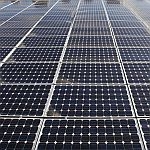 (Host) A Burlington middle school and a former race track in Pownal could soon be generating solar electricity under a new state energy program.
(Host) A Burlington middle school and a former race track in Pownal could soon be generating solar electricity under a new state energy program.
The projects were among 16 that were selected this week through an unusual process. The state held a lottery because it was flooded with requests from companies seeking to qualify for a guaranteed, 20-year electric rate for renewable energy.
VPR’s John Dillon reports:
(computer mouse clicks)
(John Spencer) "Here’s the list of our solar projects. It’s a long list."
(Dillon) When the state holds a lottery, it doesn’t always use bouncing ping pong balls to select the winning prize.
At the Vermont Public Service Board, John Spencer hunched over a computer keyboard and activated a random number generator.
(Spencer) "There they are. Now we’ll sort them…"
(Dillon) In a micro-second, the computer chose 16 solar projects that will qualify for a new state renewable energy program.
Spencer said the state was forced to use the lottery because it was flooded with requests by renewable developers trying to qualify for the guaranteed electricity rate.
(Spencer) "The solar people are victims of their own success."
(Dillon) Developers have plans to put solar arrays on schools, restaurants – even an Old Navy store in downtown Burlington.
One of the bigger projects to qualify will spread over several acres at the former Green Mountain Racetrack in Bennington County.
Solar entrepreneur John Guerin is working with the track’s owner, who is seeking to develop an energy park at the site. He says solar companies look for a flat ground with good exposure to the sun.
(Guerin) "And the racetrack is perfectly suited, because it is already graded. There is already a fence there so our security costs go down. Also due to the high power needs of the racetrack there is a lot of infrastructure already in the ground like conduits and high-graded power lines. So connection-wise it will bring down our costs considerably."
(Dillon) Guerin says the next step is to firm up financing for the project.
He says the company will now find investors who want to take advantage of federal and state tax credits for renewable energy.
On the other end of the state in Burlington, Andy Broderick is putting together deals to build solar arrays on the roofs of public schools. Broderick says public subsidies – in the form of higher rates and tax credits – are essential for financing.
(Broderick) "Between the feed in tariff and the federal solar tax credit, it allows the economics to work."
(Dillon) The state renewable program includes small scale wind, solar, biomass and methane projects. The program is capped at 50 megawatts, about 4 percent of the state’s total electric demand.
For VPR News, I’m John Dillon in Montpelier.